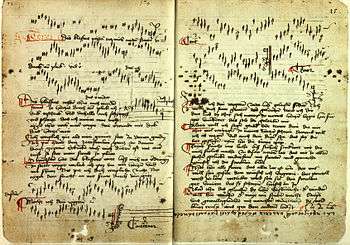Lochamer-Liederbuch

The Lochamer-Liederbuch (Lochamer Song Book or Locham Song Book) is an extensive collection of German songs at the transition from the late Middle Ages to the Renaissance. It dates from the mid-15th century and is regarded as one of the most important surviving collections of music from fifteenth-century Germany. Other names are Locheimer and Lochheimer Liederbuch.
Description
The song manuscript comprises 45 songs in one-part to three-part settings on 93 pages. 44 songs are in German, one is Dutch.[1] Other sources arrive at 47[2] or 50 songs.[3] The differences in numbering come from some songs existing in several versions; some melodies are fragmented or without text or title. For almost half of the songs, the book is the only source.

The main scrivener was some friar Jodocus of Windsheim, who is thought to have been a student of the school of the Nuremberg organist and composer Conrad Paumann. The bulk of the collection dates from the years 1451 to 1453; supplements were added until 1460. [3] The collection shows the increasing value of secular songs, along with sacred ones, including "All mein’ Gedanken, die ich hab" (All my thoughts that I have), "Ich fahr dahin" (I go away), "Der Wald hat sich entlaubet" (The forest is leafless) and "Ich spring an diesem Ringe" (I jump in this circle). Individual songs can be assigned to authors of late medieval manuscripts, namely the Monk of Salzburg and Oswald von Wolkenstein ("Wach auf, mein Hort", Wake up, my darling).[1]
The second part of the manuscript, titled Fundamentum organisandi, includes 31 organ tablatures by Conrad Paumann.[1] The two parts, created independently, were combined soon after their origin.
The Lochamer-Liederbuch was part of the library of the Prince of Stolberg-Wernigerode in Wernigerode. It was sold in 1931 and is now located in the Berlin State Library.[1] It is regarded as "one of the most important surviving collections of music from fifteenth-century Germany".[2]
This song manuscript was critically edited by Friedrich Wilhelm Arnold and first published by Friedrich Chrysander in Leipzig in 1867 in his Jahrbuch für musikalische Wissenschaft, Bd. 2 (Yearbook for musical science, vol 2).
Name of the songbook
The songbook was named after one of its first owners, who entered his name around 1500 as "Wolflein von Locham[e]r ist das gesenngk büch" (the song book belongs to Wolflein von Lochamr). For a while it was assumed that he was Jewish, because the given name is common among Jews and the book contains writing in Hebrew. The addition of "Lochamer" was then understood as referring to one of several villages called Lochheim. But it is now confirmed that the dedication was written by someone not familiar with Yiddish or Hebrew, and that Wolflein Lochamer was a member of a Christian Nuremberg patrician family.[1]
Recordings
- 14 Lieder und Instrumentalstücke aus dem Locheimer Liederbuch und dem Fundamentum Organisandi von Conrad Paumann; Hans Sachs: 5 Lieder. Nürnberger Gambencollegium, Josef Ulsamer. Archiv Produktion APM 14822 [LP, mono]. 1964
- Das Lochamer Liederbuch (The Locham Song Book). German Popular Songs from the 15th Century. Martin Hummel (Bariton), Ensemble Dulce Melos, Marc Lewon (Leitung). Naxos 8.557803. 2008[3]
Modern editions
- Ameln, Konrad, ed. (1972). Lochamer-Liederbuch und das Fundamentum organisandi von Conrad Paumann (Faksimile-Nachdruck). Kassel: Bärenreiter. ISBN 3-7618-0406-7.
- Salmen, Walter; Petzsch, Christoph, eds. (1972). Das Lochamer-Liederbuch. Denkmäler der Tonkunst in Bayern. N. F., Sonderband 2. Wiesbaden: Breitkopf & Härtel.
- Lewon, Marc (ed.). Das Lochamer Liederbuch in neuer Übertragung und mit ausführlichem Kommentar (in German). Reichelsheim: Verlag der Spielleute.
- Volume 1 (2007) ISBN 978-3-927240-83-4
- Volume 2 (2008) ISBN 978-3-927240-84-1
- Volume 3 (2009) ISBN 978-3-927240-85-8
References
- 1 2 3 4 5 Kandler, Johannes (23 January 2012). "Lochamer Liederbuch" (in German). Historisches Lexikon Bayerns. Retrieved 25 February 2013.
- 1 2 Pursglove, Gly (2008). "Das Lochamer Liederbuch: German Popular Songs form the 15th Century". musicweb-international.com. Retrieved 25 February 2013.
- 1 2 3 Veen, Johan van (2008). "Das Lochamer Liederbuch (The Locham Song Book)". musicweb-international.com. Retrieved 25 February 2013.
Further reading
- Kandler, Johannes (2005). "Wie klingt die Liebe? Anmerkungen zur Wechselwirkung von Musik und Text im Lochamer-Liederbuch". Deutsche Liebeslyrik im 15. und 16. Jahrhundert (in German). Amsterdam et al. pp. [47]-64.
- Petzsch, Christoph (1967). Das Lochamer-Liederbuch. Studien (in German). Munich: Beck.
- Petzsch, Christoph (1985). "Lochamer-Liederbuch". In Ruh, Kurt. Die deutsche Literatur des Mittelalters. Verfasserlexikon. New edition (in German). 5. Berlin: de Gruyter. cols. 888–891. ISBN 3-11-009909-8.
- Salmen, Walter (1949). Das deutsche Tenorlied bis zum Lochamer Liederbuch (Ph.D.) (in German). Münster.
- Salmen, Walter (1951). Das Lochamer Liederbuch: Eine musikgeschichtliche Studie (in German). Wiesbaden: Breitkopf & Härtel.
- Fellerer, Karl Gustav (1952). "Das Lochamer Liederbuch in der Bearbeitung der Annette von Droste-Hülshoff". Musikforschung (in German). Kassel-Basel. 5.
External links
| Wikimedia Commons has media related to Lochamer Liederbuch. |
| Wikisource has original text related to this article: |
- Lochamer-Liederbuch: Scores at the International Music Score Library Project
- Berlin, Staatsbibl., Mus. ms. 40613 in "Handschriftencensus" (German)
- Lochamer-Liederbuch in Digital Image Archive of Medieval Music, bibliography
- Wolfgang Lempfrid: Musik für Haus und Kammer – Die Liederbücher des Wölflin von Lochamen und des Hartmann Schedel Süddeutscher Rundfunk (German)
